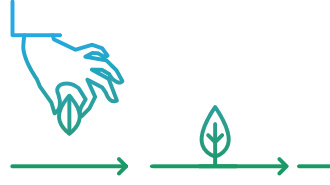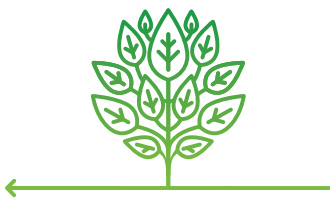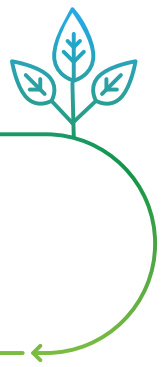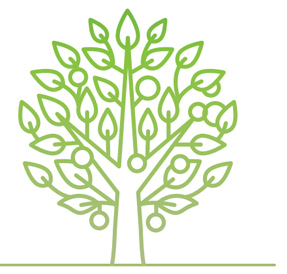Seed Funding: Small Investments with Tremendous Dividends
By Catherine McCorkle

Like ripples across a pond, individual alumni donations can have long-lasting effects, reaching destinations far from where the pebble was originally cast. This has been the case at the College of Medicine, where a single gift directed toward critical COVID-19 research has grown exponentially in the area of vaccine development. There were immediate, short-term outcomes along the way as well, yet the investigations being conducted by College faculty have the long-term potential to benefit entire populations.
Smaller donations that yield large dividends are known as seed funding. The image of a seed is an apt one, since one relatively small investment, like a single seed planted in the ground, has the potential to generate substantial benefits. Earlier this year at the College of Medicine, a generous alumni donor, who wishes to remain anonymous, made a gift toward accelerating research around COVID-19. This donation formed the backbone of what quickly became the College’s Innovation Fund.

Tracking one project team that benefitted from the fund vividly illustrates the impact of seed funding. In April, Michele Kutzler, PhD, associate dean for faculty and associate professor, and Elias Haddad, PhD, professor, both in the Departments of Medicine and Microbiology & Immunology, and their team received $10,000 from the Innovation Fund. Kutzler identifies several immediate outcomes that strengthened her project along the way: pivoting to high-risk/high-reward research, forming new faculty partnerships, and investing in professional development.
A Focus on Pressing Needs
Seed funding often empowers faculty to shift from prior research endeavors to those of a critical nature. Right now, that’s COVID-19 vaccines, treatments and therapies, so Kutzler and Haddad began vaccine and adjuvant research. At this early stage in the process, funds were used to design a nucleic acid–based vaccine against the spike protein of SARS-CoV-2 and to begin preliminary tests with the adjuvant to look at enhancing vaccine durability. Additionally, with seed money from the Innovation Fund, colleagues in Drexel’s College of Engineering developed a way to 3D print individual personal protective gear, and College of Medicine Dean Charles Cairns created a health tracker smartphone app, all to be used in the labs. “Those seed funds were critical for providing startup money necessary to get innovative ideas off the ground, and the funded projects have had a lasting impact on the University’s response to COVID-19,” Kutzler says.
Particularly for senior faculty, seed funds can stimulate research into new, impactful areas of scholarship. Researchers can be “a little more risky,” Kutzler explains, in expanding a project’s scope. Likewise, junior or non-tenure track faculty can take the risk of pivoting to work perhaps not typically funded by many granting agencies. She adds, “There’s a high-risk, high-benefit reward that really builds from those seed funds for faculty at all levels of their career.”
Innovation Through Collaboration
Building partnerships among faculty is another immediate benefit of seed funding. For instance, various groups were allocated resources from the Innovation Fund. Each conducted separate investigations around COVID-19 vaccines, treatments and therapies. Through new partnerships, it became clear that aspects of the individual projects were complementary, with the goal to test a next-generation COVID-19 or pan-coronavirus vaccine strategy.
For instance, Sonia Navas-Martin, PhD, associate professor in the Department of Microbiology & Immunology, is building an ex vivo system — growing lung cells on a chip to infect them with coronavirus. “We’re going to see if the antibodies neutralize the virus and prevent infection of human lung tissue,” says Kutzler. “It’s a very relevant model to translate what we see in our experimental preclinical models.” Irwin Chaiken, PhD, professor in the Department of Biochemistry & Molecular Biology, will bring his expertise in protein chemistry to help the team characterize the kinetics of the binding properties of the antibodies elicited by the vaccine and adjuvant.

Thanks to this faculty collaboration, three Drexel teams came together as a sort of “supergroup” and applied for a large state grant funded by the Coronavirus Aid, Relief, and Economic Security (CARES) Act. This Drexel group — led by Kutzler, Haddad, Chaiken, Navas-Martin and Julio Martin-Garcia, associate professor, Department of Microbiology & Biology — received a $1 million grant from the Commonwealth in support of their research into a vaccine adjuvant that improves durability and the quality of protective antibodies. It was the largest award given for COVID-19 research in Pennsylvania. Through pre-existing grants, Drexel provided an additional $1 million. This grant was instrumental “to improve the infrastructure to support emerging infectious disease research in the Department of Microbiology & Immunology,” Kutzler says. In order to work with coronaviruses, the existing Biosafety Level 3 laboratory was modified and improved to accommodate these new studies, thus expanding the types of high-impact research that can be done.
Professional Growth
As an added benefit, some of the Pennsylvania grant will provide opportunities to train post-doctoral fellows and medical and graduate students in research on infectious disease. This is an example of what Kutzler identifies as the third immediate benefit of seed funding: professional enrichment for the next generation of scientists.
Most grants have clear parameters about the type of research expected and outcomes to be achieved. Yet faculty can benefit from other types of enrichment as well. For instance, through a seed fund, they may be able to work in another institution’s lab, then bring that lab’s techniques back to their university. “Seed funds could also be used for an activity that helps faculty achieve their professional goals,” Kutzler says. “It may not result in a research work product or a publication or funding, but through building networks and collaborative science, it would advance the academic missions of the university.”

In this environment of risk-taking, professional collaboration and enrichment, inquiry and innovation cannot be far behind. More faculty are in a position to “write larger grants now that they have these new partnerships, or they have an expanded technique or the expanded expertise because of that seed grant,” Kutzler says.
With that initial $10,000 investment from the Innovation Fund, Kutzler and her colleagues were able to quickly pivot their research into a high-risk area and build new partnerships in the process. When the Commonwealth announced its COVID-19 grant in July, there was only a three-week turnaround for applications. Yet because the Drexel teams had already crafted their initial proposals for the Innovation Fund, the bulk of the application was already written. “A lot of institutions weren’t able to make that deadline,” Kutzler says. They built on their partnerships to propose a multifaceted project that was more comprehensive than any one investigator could manage when working alone.
A Promising Future
As a result of this work, the team was invited to apply for a large, multi-year NIH grant from the National Institute of Allergy and Infectious Diseases. “We would have never been able to write this grant,” explains Kutzler, “without the early investigations made possible by seed funding. We basically designed the vaccine construct and tested the immune adjuvant with these funds.” When they were asked to apply for the NIH grant, the work accomplished in the spring “gave us preliminary data and proof of concept that we used to show feasibility.”
The team’s NIH proposal is to develop an immunoadjuvant system for the next-generation COVID-19 vaccine. “We’ll need continuing updates to the initial vaccine. The aim of our adjuvant research program is to create a dose-sparing platform, enhance immunogenicity in older individuals, and improve the durability of the vaccine immune response,” Kutzler explains. “There’s some data that suggests that when someone generates an antibody response to coronaviruses, it doesn’t last very long. So, our research is focused on enhancing the immune response. Our hope is that future vaccines would protect people for more than one year.”
The scope of the NIH grant and its possible impact is significant. “We’re going to try to turn this first million awarded into a larger award of over $5 million, so the initial investment made from the seed grant will have lasting impact on research at Drexel for many years,” Kutzler says.
While the Drexel team won’t learn whether they’ve received the NIH grant for several months, this process is undoubtedly “an example of alumni donations that grow exponentially,” says Kutzler. From one seed donated by a generous alum, the College is on the verge of creating an entire forest. In the arena of COVID-19 vaccines, treatments and therapies, that cannot happen soon enough.
Back to Top